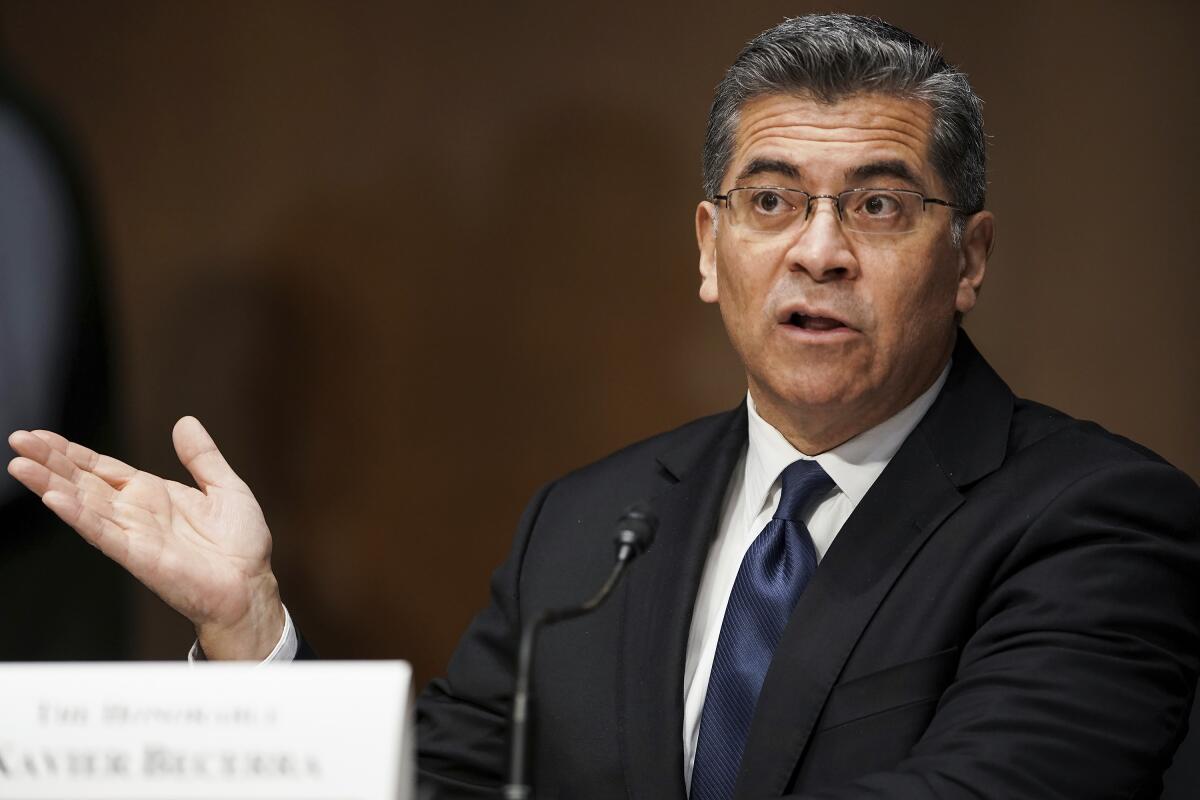Atty. Gen. Becerra joins lawsuits challenging housing projects in wildfire areas

- Share via
SAN DIEGO — Suburban housing proposals in California are facing ever greater scrutiny over wildfire concerns, with Atty. Gen. Xavier Becerra taking his most recent stand against development in high-fire areas on Wednesday.
Becerra joined lawsuits against two proposed developments in San Diego County, in the hilly scrublands east of Chula Vista.
“Devastating wildfires have become the norm in recent years, with dozens of deaths and whole towns forced to evacuate,” Becerra said in a statement. “That’s why local governments must address the wildfire risks associated with new developments at the front end.”
Specifically, Otay Ranch Village 14 would place more than 1,100 homes on a two-lane road within five miles of 68 recorded blazes, including the Harris fire in 2007. Otay Ranch Village 13 would construct more than 1,880 homes on a site that’s repeatedly burned, including the 2003 Otay fire.
Becerra also noted that neither of the projects set aside any units for affordable housing.
Becerra’s move to quash rural developments in San Diego follows similar efforts in Lake and Monterey counties.
“The intervention of the attorney general is a fascinating escalation of power, effectively to force counties to do what they’ve rarely done — which is to rethink their greenlighting of any development at any place,” said Char Miller, a professor of environmental analysis at Pomona College who has written extensively about wildfires.
The San Diego County Board of Supervisors approved both Otay Ranch projects with the support of local California Department of Forestry and Fire Protection officials. During public hearings, politicians, such as former Supervisor Greg Cox, stressed the need for more housing, while San Diego County Fire Chief Tony Mecham testified that residents could be safely evacuated in a large blaze.
Building industry officials on Wednesday also touted the support of local fire authorities for many rural housing projects.
“We think [Becerra] is stepping over the line, primarily because you can’t build in these areas without putting together a very sophisticated plan fully approved by the local fire chief,” said Dan Dunmoyer, president and CEO of California Building Industry Assn.
Aside from California’s strict building codes in wildfire areas, “we are building parks, we’re building entire infrastructure systems that don’t burn and can protect these communities from fires,“ he added.
The projects in question in San Diego are the tail end of the county’s largest residential development to date, the 23,000-acre Otay Ranch master-planned community in Chula Vista.
Jutting into chaparral and other scrublands, the development proposals have drawn the ire of environmental groups concerned about habitat destruction, wildfire and greenhouse gas emissions from long car trips.
The Center for Biological Diversity, Endangered Habitat League, Sierra Club, California Chaparral Institute and other groups challenged the projects in San Diego Superior Court in 2019 and 2020.
The lawsuits came on the heels of a string of litigation by green groups against rural development around the region. At one time, county officials were considering more than half a dozen proposed housing developments totaling roughly 10,000 units all in high-fire areas.
Since then, environmentalists have rung up one court victory after another, including overturning the county’s climate plan, which would have allowed developers to pay their way around greenhouse-gas restrictions using carbon offsets. Almost all of the rural developments have since been put on ice or abandoned, most notably the roughly 2,100-home Newland Sierra north of Escondido.
Such legal challenges against suburban development received a significant boost in 2018 when the state updated the California Environmental Quality Act to, among other things, tighten the rules around approving housing developments in wildfire-prone areas.
In 2019, Becerra’s office directly raised concerns with the county about Otay Ranch Village 13 and the potential for catastrophic wildfire. That year, he also took aim at the proposed Paraiso Springs Resort in Monterey County.
San Diego County officials responded to the attorney general, saying, “There is no evidence that higher density residential development in San Diego County, including development in the wildland-urban interface, has increased fire-ignition frequency.”
Becerra’s office shot back with another letter in November restating its concerns and pointed out that Otay Ranch was just one of several development proposals that “fails to adequately assess the cumulative impact on fire risk posed by siting these developments in this very high fire-hazard severity zone.”
Last month, Becerra backed court challenges in Northern California alleging that officials failed to properly account for increased wildfire risk when approving a massive international resort in Lake County that includes 1,400 homes and 850 hotel rooms.
Smith writes for the San Diego Union-Tribune. The Associated Press contributed to this report.
More to Read
Sign up for Essential California
The most important California stories and recommendations in your inbox every morning.
You may occasionally receive promotional content from the Los Angeles Times.














